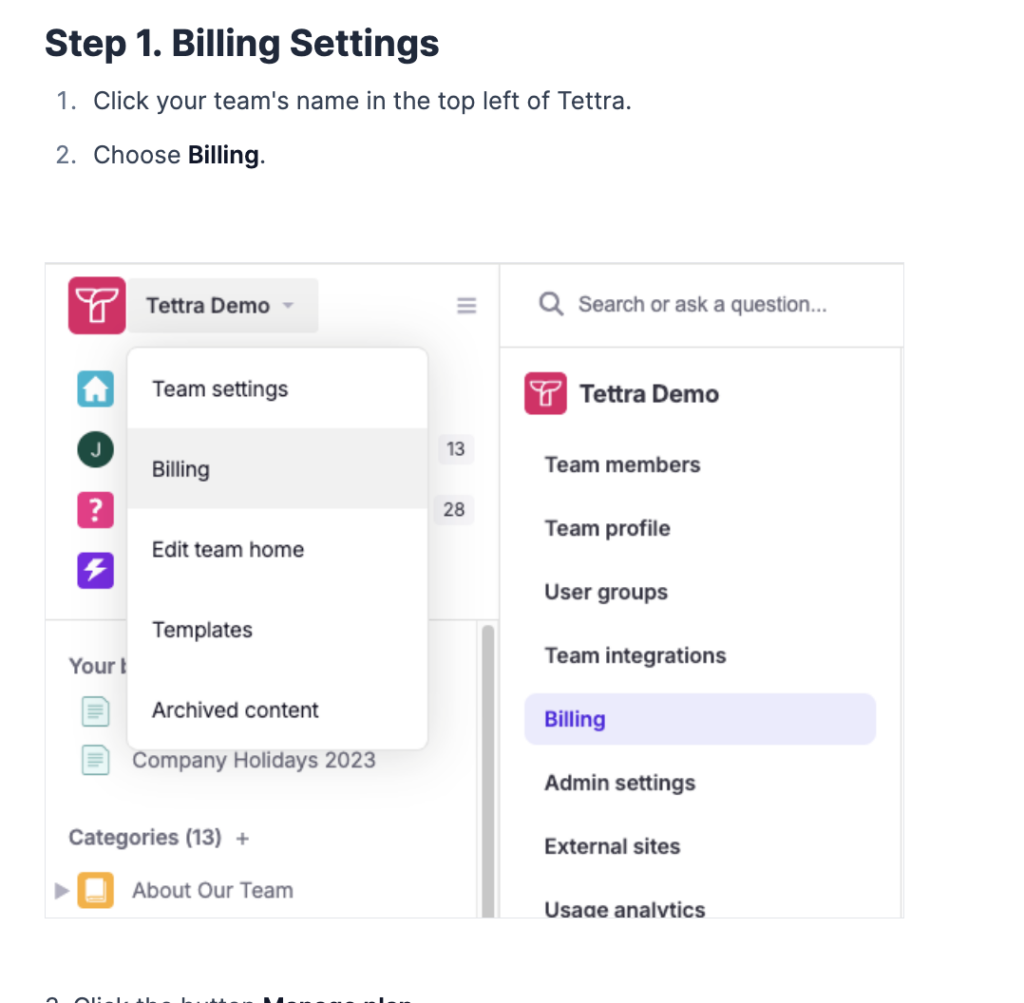What is a Knowledge Base Article?
A knowledge base article is an invaluable resource designed to provide comprehensive information on specific topics or issues, typically within an organization’s internal or customer-facing knowledge base.
An effective knowledge base article is crafted to answer questions, solve problems, and guide users through tasks or processes, utilizing a structured and accessible format to facilitate easy understanding and application.
Importance of Knowledge Base Articles in Customer Support
Great knowledge base content is foundational to offering exceptional customer support. They empower customers with easy access to information, enabling self-service solutions that significantly reduce the need for direct contact with support teams. This autonomy not only leads to faster resolution times but also enhances customer satisfaction by providing immediate answers. Furthermore, by deflecting common queries, these articles contribute to reduced support costs, optimizing the overall efficiency of the support function.
Benefits of Using Knowledge Base Articles for Customer Service
Incorporating knowledge base articles into your customer service strategy offers a lot of benefits.
- They serve as a first line of support for customers
- They are a reference point for employees
All of these help simplify and hasten the support process.
By furnishing detailed solutions and information, these articles reduce the reliance on guidance from support agents, decrease the volume of repetitive inquiries, and shorten the time customers spend awaiting responses. This leads to an overall improvement in service quality and customer experience.
More:
How To Create Effective Knowledge Base Articles
Creating impactful knowledge base articles requires a deep understanding of your audience, the right format, clear and concise writing, comprehensive step-by-step instructions, and the strategic use of visuals.
Each element plays a crucial role in ensuring that your knowledge base is not only informative but also engaging and accessible to all users.
“Giving your customer the most impactful information at the beginning is respectful of their time, and also helps them to digest the rest of the details you provide more easily,” says Jen Weaver, customer success manager at Tettra.
1. Understand Your Audience
To craft effective knowledge base articles, start by developing customer personas to grasp the technical understanding and preferred learning styles of your audience. Utilize common questions to tailor your content, thereby minimizing support tickets.
Consider incorporating customer feedback mechanisms and behavior analytics into your strategy, ensuring your knowledge base meets the real needs of your users.
2. Choose the Right Format for Your Knowledge Base Article
Knowledge base articles can take various forms, including step-by-step guides, FAQs, troubleshooting guides, and product documentation.
Each format serves a distinct purpose and caters to different user needs. It’s essential to choose the right format for your content, incorporating key elements such as clear titles, concise instructions, and appropriate visuals to enhance clarity and effectiveness.
Tettra has lots of templates to choose from for your internal processes, such as SOP templates and post-mortem templates.
3. Write Clear and Concise Content
The clarity and conciseness of your content are paramount.
Use simple language, avoid jargon, and ensure your articles are structured in a user-friendly manner.
A well-organized hierarchy, clear headings, and efficient search functionality are critical to helping users find the information they need quickly and effortlessly.
Jen from Tettra also suggests providing a quick summary near the beginning of the article.
“Vive a short summary of the answer at the top of the article, and then go into detail below,” she says.
She points to this Tettra support article as a good example.
It has a clear heading, what the user can learn from it, and then step-by-instructions with more detail.

4. Include Step-by-Step Instructions
Detailing step-by-step instructions is vital for procedural clarity. Use numbered lists or bold text to emphasize each step, and include links to related resources. Ensure your instructions are precise and considerate of the user’s level of expertise to avoid confusion and ensure successful task completion.
5. Use Visuals to Enhance Understanding
Visuals play a significant role in enhancing comprehension and engagement. Incorporate screenshots, infographics, and charts to illustrate concepts clearly and make your content more appealing.
Tools like Canva and Snagit can simplify the creation and capture of these visuals, making your articles more accessible to visual learners.
Here’s another example from the aforementioned Tettra article:

6. Create Knowledge Base Article Templates
Creating a versatile and customizable template for your knowledge base articles ensures consistency and professionalism across your content.
Here are ones in Tettra to help you get started.
7. Organize Information in a Logical Sequence
The organization of your content should follow a logical sequence, enhancing the article’s clarity and effectiveness.
Outline the main points, use transitional phrases for smooth flow, and consider organizing information chronologically, by importance, or by cause and effect to ensure coherence.
8. Using Headings and Subheadings Effectively
Headings and subheadings are invaluable tools for structuring your content. They facilitate skim reading, improve SEO, and help organize information into digestible sections. Keep your titles simple, focusing on action words to capture the reader’s attention.
9. Incorporating Bullet Points for Easy Reading
Bulleted lists make your content easier to scan and comprehend. Use bullets, tables, and other formatting elements to break up text and guide readers through your content efficiently. Linking to related articles can further enrich the reader’s understanding and exploration of topics.
Get more tips on knowledge bases from Tettra:
- Simple guide to internal knowledge bases
- What is a company knowledge base?
- Internal vs external KB and why you need both
- 5 reasons why your company needs a knowledge base
- 9 top AI knowledge base software
- 11 best knowledge base software to check out
Why an Internal Knowledge Base like Tettra Can Help Your Team
- Centralize Company Knowledge
An internal knowledge base serves as a centralized single source of truth for all company knowledge. This centralization is vital for organizations because it ensures that all employees have access to the same information, policies, procedures, and solutions.
Tettra’s AI-powered system simplifies the curation and organization of this information, making it easily accessible to all team members, which is crucial for maintaining consistency in practices and answers provided both internally and to customers.
2 Empower Employees
Internal knowledge bases empower employees by giving them the tools and information they need to perform their tasks more efficiently. It reduces the time spent searching for information or seeking assistance from colleagues, leading to increased productivity and a more autonomous workforce. With Tettra, employees can get quick answers to their questions through the platform’s advanced search capabilities and integrations with Slack and MS Teams, enabling them to resolve issues without delay.
3. Facilitate Onboarding and Training
An internal knowledge base is an invaluable resource for onboarding new employees. It provides them with a comprehensive resource to learn about company processes, products, and services at their own pace.
This accelerates the training process and helps new team members become productive more quickly. Tettra’s easy-to-navigate interface and structured content make it an ideal platform for creating and managing onboarding materials.
4. Enhance Collaboration and Knowledge Sharing
Tettra encourages collaboration and knowledge sharing within organizations. By allowing team members to contribute to and update the knowledge base, it ensures that the information remains current and comprehensive. Designating “knowledge experts” within the system can further enhance the accuracy and reliability of the information provided. This collaborative approach fosters a culture of learning and continuous improvement.
5. Reduce Redundancies and Support Costs
An internal knowledge base significantly reduces redundancies in answering frequently asked questions and solving common problems. This not only saves time for employees but also reduces the workload on customer support teams, as many issues can be resolved through self-service options provided by the knowledge base. Consequently, organizations can achieve lower support costs and improved customer satisfaction, as customers appreciate being able to find quick and easy solutions to their problems.
6. Ensure Knowledge Retention
An internal knowledge base, especially one managed with Tettra, mitigates this risk by documenting critical company knowledge. This documentation ensures that valuable insights and information are preserved, even as employees transition between roles or leave the company. It safeguards against the loss of expertise and maintains the continuity of operations.
Leveraging Tettra’s AI-powered knowledge management system to maintain an internal knowledge base is crucial for organizations aiming to enhance efficiency, empower employees, and foster a collaborative and innovative culture. It not only supports day-to-day operations but also plays a strategic role in the organization’s long-term success and adaptability.


